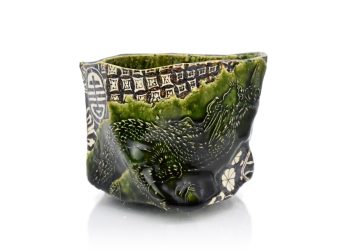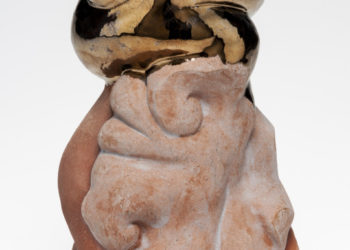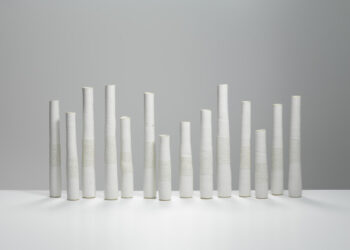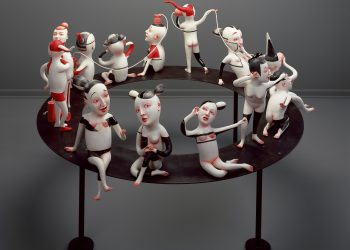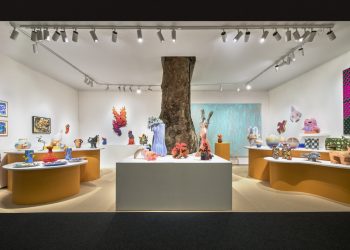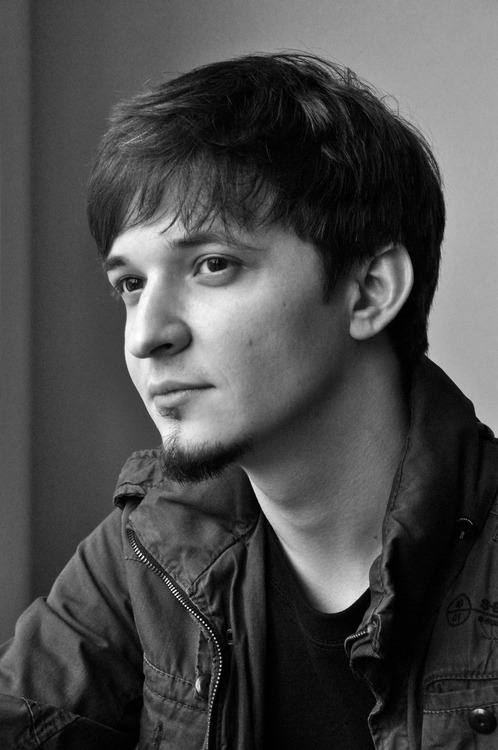
You hold functions such as curator, associate editor and columnist for different magazines, and you recently initiated a contemporary art platform titled Anti-Utopias. Since you don’t have any formal art education, how did you become interested in contemporary art?
Art has always been one of my main interests, ever since I was a kid, and though I did not follow any formal art education, I did follow an MA in philosophy and culture where some of the major topics we discussed have been Art, Institutions and Cultural Policies, The Artist’s Statute in Post-Modern Culture, or Contemporary Perspectives Upon Culture. I also follow a PhD with a thesis on the future of museums, in terms of art, policies, architecture. Throughout the years I’ve kept a close contact with art in my readings and references, and I think coming from the “outside” is actually an advantage because it allows me to view art in a broader context and integrate its discourse differently. At the same time, I am also aware of the two perils with philosophers discussing art: on the one hand, they run the risk of subsuming art to a philosophical speech; on the other hand, they can feed art with concepts that only deepen the dilemmas of contemporary art and thus contribute to its fractures. When I started Anti-Utopias, my main concern was to create a thematic platform bearing in mind these two perils precisely, but also the theoretical abundance where art in general claims itself from.
Tell us about Anti-Utopias. Why did you choose the utopian – anti-utopian motive as the theme of your project?
In spite of all the discourses on contemporary art, I think it is still trapped in a false attempt to surpass its own modernity. The artistic discourse still tries to dissect its own foundation and remains somehow captive inside artificial constructions, based on imitation. I am equally circumspect whether discourses crediting the derivative modernities can indeed not only resurrect, but actually redeem the project of modernity. These modernities are based on alter-constructions that complete the same project, though they construct on the margins of modernity. We relate to the same referent, and hope our alter-construction will indeed rescue notions and practices. Art is caught in this paradox: on the one hand, it has to constantly shift its aims outside the marges, because when you construct on the marge, the marge itself becomes a center; on the other hand, art contributes to a global process of territorialization, precisely in this movement it needs to operate. It’s like an expanding fissure that deepens the faults. And it is along this fissure that one can understand the exposure of art, in what this fissure draws ahead, but especially in what it leaves behind, not only as a trace, but in that which remains. Art is this rest, this remnant. Art is reversion. And I think this is one of the ideas and concepts that I need to develop further, this idea of art being a reversion.
When I started this project I knew I was placing its theoretical horizon under two major discursive pressures. The first one is this unsuccessful attempt to give an answer to an utopia other than by formulating another utopia, and the second is the use of the prefix “anti-“ itself, which does indeed bestir a number of critical reflexes and exercises. Obviously, there is no exit from utopia, and the more we seek to counter this statement, the more we end up in utopias of the refusal or in the utopias of some alter-constructions. From my perspective, anti-utopias don’t claim themselves from a refusal or a counter-position, nor are they the expression of a cultural, historical, or political transgression. They do not fall into the metaphysical discourse where anti- would refer to a sort of anti-metaphysics, and I don’t see them being shaped as a means of counteracting either. For me, anti- should refer to a state of exposure, to a certain openness which is not only affirmative but also all-embracing, definitive, and which can be understood on multiple levels: over-exposure, exposure to the certitude of death, exposure to a certain risk and impossibility, exposure to its own tragedy, etc. It is an exposure not only to the unpredictable, but also to a subtending dread defining art and life itself – a fear of dying, the interruption of breath. And though this discourse may seem to bear away from the current artistic discourse, I still think it is this dread that art is running away from. And this can be seen in all its diversity, separations, counter-currents, and reconsiderations. Not lastly, I think that the insistence upon difference/differences cannot account for the current state of things any longer, but only perpetuates the discursive and political impossibilities. From one utopia to another. I think art and society are on the verge of a more radical transformation, for which it has no name yet, a transformation we cannot fully appropriate right now.
In the early days of Ceramics Now I had very little data to publish, but with time many artists contacted me and showed their interest in my project. How did you start yours?
Anti-Utopias is first of all a curatorial project launched several months before the online publication of any project. I started by selecting the artists and works myself, individually, without knowing how many artists will respond to my initial call. I am still impressed to see how many artists responded in a positive way, and I think one of the greatest achievements was to create this platform around the works of so many artists using so many mediums of expression. The platform had already published an impressive number of 130 projects when it was launched, and it now counts more than 175. There are many other projects I plan to publish, but I think it is important to publish the projects in a certain rhythm and give people the opportunity to understand each project more closely and see how it relates to all the other projects in a certain category or cross-category. There are also artists who didn’t send works at first but sent their works after seeing the online platform published. In the past few weeks I’ve been quite happy to see Anti-Utopias follows the same pattern of development as Ceramics Now, with artists contacting me and submitting works. I think more artists join such projects as soon as they see and understand it as an opportunity to feature their works. And in order to do that, one needs to make a different proposition. Everybody asks for images, the main difference is what you want to do with them and how you use them to deliver another content and propose a more diverse space for discussion. Anti-Utopias is not an archive of artists and their portfolios, but an ongoing process of interpretation.
What are the biggest challenges of maintaining a live platform of contemporary arts?
I think there are two major challenges at stake. On the one hand, there are all the technical requirements, many of which you do not even think of when you first start an online project. As the project evolves, you start to invest more and more time in finding technical solutions, new ways of integrating new content and new technologies that help you shape the visitors’ experience when surfing a website. Small changes in design, layout or extra modules can radically change the user’s experience on the platform and generate an incredible wave of interest. On the other hand, you need to make sure your content is constantly bringing something new, not only in terms of the projects as such, but also in the way these projects are presented and relate to the broader perspective. There are small chances new platforms or new initiatives will be able to counter the large art, design, or architecture platforms, especially when you rely on your own efforts like I did. Yet I think this could also prove to be an advantage, because there is an increasing number of good online art projects that search for a more “collaborative” approach. Recently, Anti-Utopias signed a partnership with a project in London. My surprise was to see the quality of that project, but also the fact that this partnership relies simply and solely on the curatorial and artistic ideas that underline the two projects. Though separate in their aims, I am sure their connection will prove beneficial for both parts involved. I do think it is this “collaborative” aspect that will shape new approaches in designing the various art projects that lie ahead, and one of the future challenges I see lies in creating a certain network of projects that work separately around a common aim.
On the other hand, Anti-Utopias is not only an online platform. Every year, I plan to publish a comprehensive volume containing a selection of the best works published throughout the year, and also make a few traveling exhibitions and lectures around the world. The online platform is the most visible element of a larger project. I always work around books and catalogs, and I do hope the Anti-Utopias annual catalog itself will be a great work and project in terms of selection, theory, design, editing, print…
What inspired and motivated you to start such an ambitious project?
Anti-Utopias is based on my intention to deliver a project that can establish both a general and a critical platform for discussing contemporary art. There are few local or regional projects that try to do this, and I thought it was necessary to come up with a project that could map certain perspectives that underlie the current art practices. Local projects and platforms are oriented more towards regional enterprises, and few people adventure beyond this border and pursue a broader perspective. I’ve been inspired by many successful international projects, but I am motivated by delivering a more textual, even conflicting approach, which has yet to develop further.
Why choose deconstructivism as a recurring theme in your projects?
I’d like to make a very small distinction here. The term “deconstructivism” points to a historical and political current or manifestation, whereas “deconstruction” is a method, an ethical intervention into reality, an inner practice if you like, and it is this second acceptance I’d like to insist upon. As a concept, deconstruction already relies on the Heideggerian “destruction” and it already came after, if not too late… But unlike Heidegger’s destruction, deconstruction is an abstention and deferment from its violent and disruptive force. It is this deferment and this abstention that characterizes art, and we need to understand this abstention and deferment themselves as art. Deconstruction is, after all, an effort, an endeavor, an undertaking meant to establish the various relationships between an element and its context, and I think this process defines art in the most intimate way before any other consideration. Art is this effort and this endeavor. Art is deferment.
There is a certain negativity in my approach, but it must not be understood as a refusal, but more as an “aesthetic negativity” that goes back to Adorno’s negative dialectics and Derrida’s deconstruction, to their discussion around the sovereignty of art as a means to subvert the rules of reason. And not only of reason, because art subverts the rules of space, time, politics, representations… It is this subversion that I am taken up with. And since the critical discourse has fallen into the very holes it dug into past histories and traditions, I think it is time to re-evaluate both the critical discourse and art itself, to expose their own utopias, and in this way be anti-. There is no monolithic truth about art, and art is better understood in its distorsions, in its subversions, in its deferment… and especially in its battle with the critical discourse itself. Not lastly, I hope the future developments around this project will come to a point where people understand, even if only by looking at the selected works, that art is no longer a space defining “the works of art” but the facts of art.
You publish projects from artists living in different communities, making this project an international platform. But have you also hoped for a local impact?
I wouldn’t say impact… and not even an influence. Since there is almost no project conceived similarly, and other projects are oriented more towards the local, national, or regional art scene, I hope the least this project will do is draw attention to another approach.
Do you want Anti-Utopias to influence the Romanian contemporary art scene in a way or another?
I don’t think this project could or should “influence” the Romanian contemporary art scene. Every art scene as such is independent of the projects that try to put it into a certain perspective. And it must remain independent. The most it can do is offer Romanian artists a chance and a space to feature their works and see how they relate to the context created by international artists. The only influence on the Romanian contemporary art scene should be this drive to venture further, because most Romanian art projects – and, curiously, those that pretend to be the most subversive – rely heavily on institutionalization practices and follow “group” interests. On the other hand, I’d like to see more than just this wave of resentfulness, false revolution, and institutionalization of nostalgia. I admire Romanian artists and designers who got over the various forms of resentment, and people who understand that change comes from inside each and everyone of us.
The premise of your curatorial discourse is a very complex one. What is the target of this project? How do you expect or encourage the average art consumer to react?
This is a very good question, because I do see a split target to this project. On the one hand, there are the artists, galleries, theoreticians, curators, art institutions, and art enthusiasts; on the other hand, there is “the average art consumer” as you said. But I don’t see this split as a break in the content this project is aimed to deliver, and my intention is to be able to encourage both parts to participate to the overall discourse differently. In doing so, I think one of the most important aspects is to create a more diverse content for everyone, while still bearing in mind the curatorial aims of the project. Those who wish to simply see the works of art and find information about an artist by reading her/his biography or reading an interview will rely on the online content. Those who wish to understand more about the project itself and the way these works of art interact on a deeper level will be able to refer to the annual catalog we publish, which is supposed to contain a more complex content, including exclusive theoretical content, discussions, and projects. I am also planning to make a series of traveling exhibitions and lectures, so that people will be able to interact with this project even more. From my experience, you cannot fully anticipate what people react to, and sometimes people are interested in projects that you didn’t think they’d make such an impact. At the same time, I think “the average art consumer” is a very important target because this notion regards the majority of active subjects we’d like to involve more in assessing and understanding art and its role as a performing practice, as a way of living.
How was the project welcomed by the contemporary artists you featured? How do you see the future development of this project?
Given that when I launched this platform I had published the works of 125 international artists, some of whom are well known throughout the world, I think the project was extremely well received by the participants. I received numerous messages at that time and continue to receive encouragements from some artists every time I announce changes or updates to the project. And I think this has been one of the most important aspects in the success of this platform so far – the care and attention in talking to each artist, the attention you put into every detail of the project, from images to design and layout, etc. I also made friends among artists and enjoy the talks I have with them every now and then, which on a personal level counts way more than posting some works of art or trying to come up with a “new” discourse on art. I think it is this personal, intimate bond between artists and a curator that shapes a project. I’ve found my drive to go even further by talking frequently with some of the artists I feature, and I am grateful I have the opportunity to discuss with them.
I think there is a great deal of things the Anti-Utopias project must further develop and improve, in terms of reach, content, functionality, and access, but also in terms of its aims. Though this project is new, I’ve started making the plan for version 2.0 and developed an integrating strategy to involve more partners in the project. Hopefully, the results will appear soon and the project will be able to have a more consistent presence on the international art scene. In terms of its aims, the project will continue to build on its curatorial approach and integrate more perspectives. We just opened a section featuring artist interviews, art catalog reviews, and theoretical articles written by various artists, curators or theoreticians. There is so much you can do with such a project that the only thing you can hope for is to have the will to carry it even further.
Interview by Vasi Hirdo, published in Ceramics Now Magazine, Issue 2.
Visit Anti-Utopias’ website.
Portrait photo by Andreea David.




